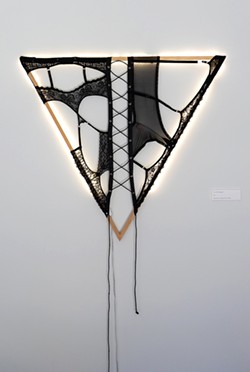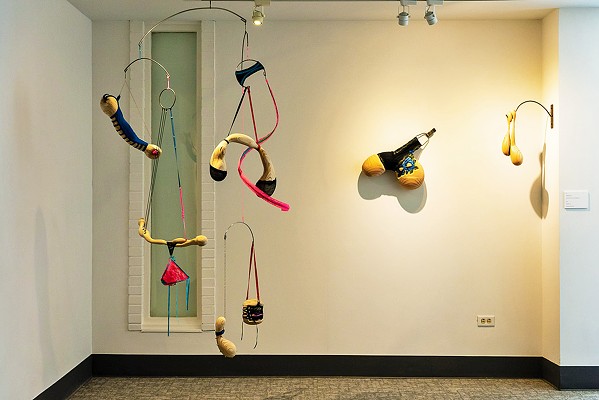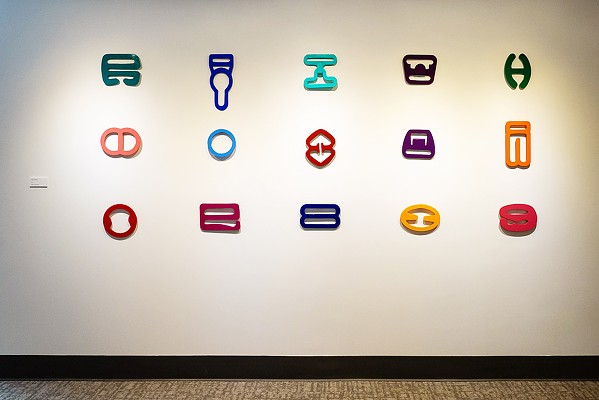Plywood grains curve, bending into a soft round shape plopped into half of an old black mesh bra. At its base, pink, red, and white petals make their way up to a misshapen second half, embroidered and pressed into the wooden beauty of Asimetría.
Artist Elisa Ortega Montilla said she's had a lot of women reach out to tell her how much they related to it.
"They all had breast cancer and it felt like a celebration of it," she said. "And the flower made it feel like the replacement of the breast that was taken."
Although that wasn't quite what Ortega Montilla was going for when she put the piece together, it's not important. What matters is how the pieces she creates speak to whoever's viewing them, she said.
"I love it when people share, because then I can see my work expanding outside of what I'm just creating," she said. "I love creating things that create confusion or create questions and just leaving it open to interpretation. ... Sometimes it's autobiographical in detail and sometimes it's just a reference point for people to look at and relate to it in different ways."

- Photos Courtesy Of Elisa Ortega Montilla
- TRAPPED Elisa Ortega Montilla's piece This Is Not A Vagina is part of her Objectifying exhibit now up at the San Luis Obispo Museum of Art (SLOMA) through the end of June.
Ortega Montilla said she's trying to develop a body of work that doesn't necessarily replicate the specific shapes of male or female body parts; rather her pieces are made up of shapes that evoke them—distortions of the body or a part of the body. Mostly, those pieces investigate what it means to be a woman, the language that we use to talk about women, and the constructs embedded in how society perceives gender. Several of Ortega Montilla's pieces are on display at the San Luis Obispo Museum of Art (SLOMA) through June 27 in Objectifying, one of the museum's first exhibits that's open to the public for in-person viewing since the COVID-19 pandemic started.
SLOMA Executive Director Leann Standish said the museum is fortunate to have Ortega Montilla's thoughtful work in their program now that SLOMA's open again. Visitors have really responded to the show, which Standish said could indicate a new direction for the museum and the kind of work it displays.
"I think it is an important show, and I'm so impressed by Elisa's beautiful pieces. The fluidity of the sculptures really strikes me," Standish told New Times via email. "Elisa was a social worker before she dedicated herself to her art, I think that is relevant and important when considering exhibitions for the museum. Our programs are meant to explore interdisciplinarity and ways that the work on our walls can teach us something about the world we live in."
SLOMA's role in the community, Standish said, is to inspire conversation and facilitate a place where discourse can take place.
As a social worker, Ortega Montilla worked with women in the gypsy community of Spain as well as victims of domestic violence in Guatemala. In 2012, she moved to the United States from Spain because of the country's economic crisis. She did social work in LA with women from the LGBTQ-plus community and case management with homeless youth in Hollywood for about five years before applying to art school at UC Santa Barbara.

- Photos Courtesy Of Elisa Ortega Montilla
- ANATOMíAS Ortega Montilla's series of sculptures in Objectifying seeks to question traditional gender roles and the way society teaches us to view our bodies, but she likes to leave her pieces up to interpretation. "It can be female parts, male parts. But it can be anything. It can be a worm, it can be an animal," she said.
The art she creates is an intimate reflection of her lifetime experiences, as a social worker, as a woman, as a feminist, as a Spanish woman in the United States, as a child who grew up in Spain a decade after it transitioned from a fascist dictatorship. Austerity measures that her parents lived through were very much a part of her childhood.
"Everything that I wore was like mended or fixed, everything had second and third and even fourth lives if they could be fixed," she said.
Which is part of the reason why her art recycles already used products, such as reclaimed beams, old pieces of plywood, and used women's underwear. Ortega Montilla takes care to ensure the wood shows that it's on a second life. Glue seams, screws, and the bruises that come with use break up the perfection of the wood she sculpts.
"As an artist I was really interested in giving life to materials that were discarded, especially now, because consumerism is at an all-time high," she said. "Using reclaimed materials is trying to aim with those values of sustainability."
A painter in high school, Ortega Montilla applied to school with a portfolio of figurative paintings of women—the untold history of women she wasn't taught about in school. But when she arrived at UC Santa Barbara, she came across the woodshop while she was on a tour of the art facilities.

- Photos Courtesy Of Elisa Ortega Montilla
- RESTRAINED Clips often found on female underwear "to me are just instruments of pain. It's what makes underwear or bras so uncomfortable," said Ortega Montilla, who created the gigantic metal versions of them hanging on the wall at SLOMA through June 27.
"I was like, 'fuck, I have to be here,'" she said. "I just felt a very visceral attraction to being in this space and working with wood."
Although UC Santa Barbara doesn't teach wood-sculpting classes, Ortega Montilla taught herself how to sculpt it with the help of a woodshop technician—which is what she does now.
Everyone will understand her work based on their own perspectives, Ortega Montilla said, but the body parts she sculpts and the way she attaches pieces of fabric to them create images that are familiar to everyone simply because of the way society talks about gender.
"If I allow my intuition to guide me, and I just focus on the materials and what they do to each other, then these things happen in a very subtle way," she said. "Like a coincidence or not, because it's all based on the images we are exposed to as women." Δ
Editor Camillia Lanham thinks society is distorted. Send arts story ideas to [email protected].

Comments